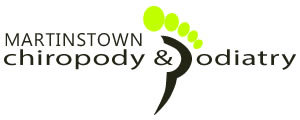Corns
An area of skin which is exposed to pressure or friction causing a circular area of very dense skin to form which becomes embedded in the skin causing scarring in the underlying skin which can be extremely painful. Footwear is a frequent cause of corns. The X ray below shows the pressures on the ball of the foot while standing in a high heel shoe.
Callous
A sheet of skin which becomes hardened due to pressure or friction usually on ball or around heels of the foot. This hard skin can be removed and advice given to prevent reoccurrence.
Verrucae
A viral infection of the skin caught from damp communal floors, similar to a wart on the fingers. A variety of treatment options are available and can be discussed to decide on the most appropriate for the person.
Ingrowing Toenails
Toe nails which become embedded in the skin, can bleed and become infected. Often caused by poor cutting of nails or trauma. These can be treated by removing the offending piece of nail through either a temporary or permanent procedure.
Athletes Foot
Fungal infection of the skin which usually starts between the toes and can lead to an itchy feeling in and around the infected area. The fungal infection can also result in scaling and flaking of the skin and can lead to the development of fungal nails. Treatment of the problem depends on the cause
Biomechanical problems
Biomechanics is a detailed assessment of how the foot interacts with the ground, a variety of pathological conditions can occur including:
- Forefoot pain
- Metatarsalgia (pain in the balls of the feet)
- Morton’s Neuroma (enlarged trapped nerve)
- Bursitis (inflamed fluid filled sack)
- Midfoot Osteoarthritis
- Flat Feet
- Plantar Fasciitis (pain in the arch of foot worst in the heel in the mornings)
- Heel Pain
- Achilles Pain
- Ankle Pain
- Shin Splints (severe pain in the shin, occurs while walking)
- Knee Pain
- Hip or Lower Back Pain
- Lower Limb Sports Injuries
These conditions are often caused by the overdevelopment of certain muscles muscle groups, often accompanied by underdevelopment of other muscle groups and are usually compounded by excessive pronation.
Pronation is the normal rolling in of the foot on contact with the ground. However excessive pronation can weaken the arch structure of the foot putting extra strain on the heels, knees, hips and lower back, if untreated this can lead to significant pain in these areas.
Treatments involve identification of the cause of the problem and were necessary muscle stretching and /or muscle building exercises and the use of orthotics to correct the excessive pronation.
Podopaediatrics
Podopaediatrics is an area of podiatry focussing on the treatment of children and the various afflictions that can affect a young person’s lower limbs. Proper Podopaediatrics care is important in the long term because unaddressed structural problems with the feet can worsen overtime, eventually causing severe issues with gait and pain. By correcting early foot deformities many long term chronic mobility issues can be safely and effectively addressed, sparing a great deal of discomfort on the part of the patient, and expense on the part of the NHS.
A number of different foot ailments can affect children from a variety of different backgrounds, these can include structural issues with the foot like flat footedness, or other, more general issues like ingrown toe nails or infections.
A biomechanical assessment of a child has to be interpreted based on the specific age of the child and where necessary age appropriate advice provided.
Orthotics Management
Orthotics are quite rigid devices, that look like arch supports but which are specific to treating that patient’s problem. Orthotics are similar to prescription glasses for correcting eye problems but are used for correcting specific foot problems.
Diabetic Foot Health
Assessment and treatment of the Diabetic foot. See frequently asked questions for information on the Diabetes and the feet.
Thickened or discoloured Nails
This condition is usually caused by trauma to the nail and can result in the nail either becoming thickened and in some cases infected with one of three possible fungi types. The nails can be reduced and if necessary the infection treated.
Cracked Heels
Dehydrated skin on the heel and sole of the foot can becomes cracked and sore. This skin can be debrided to give relief and personalised advice given on preventing reoccurrence.

